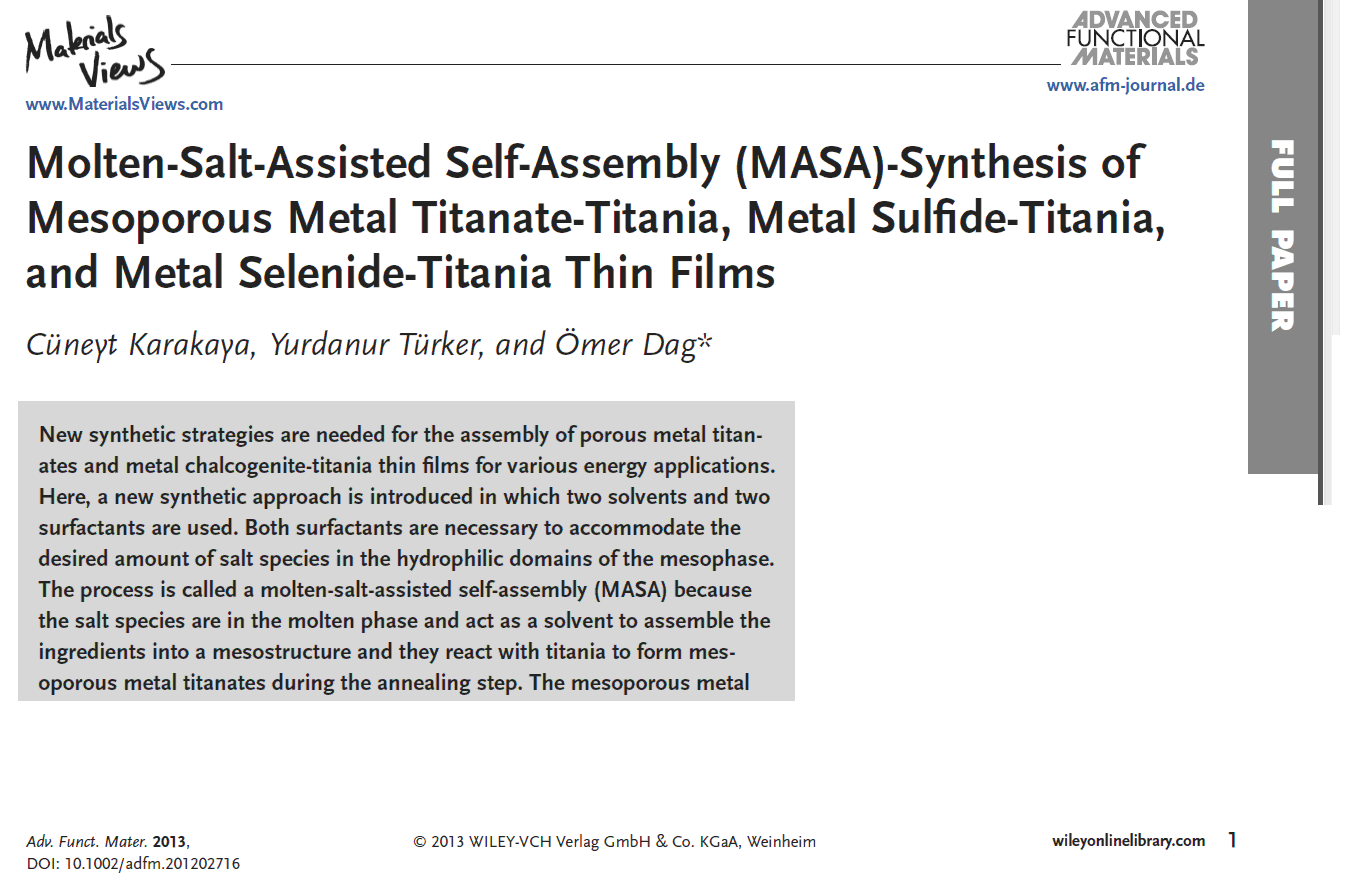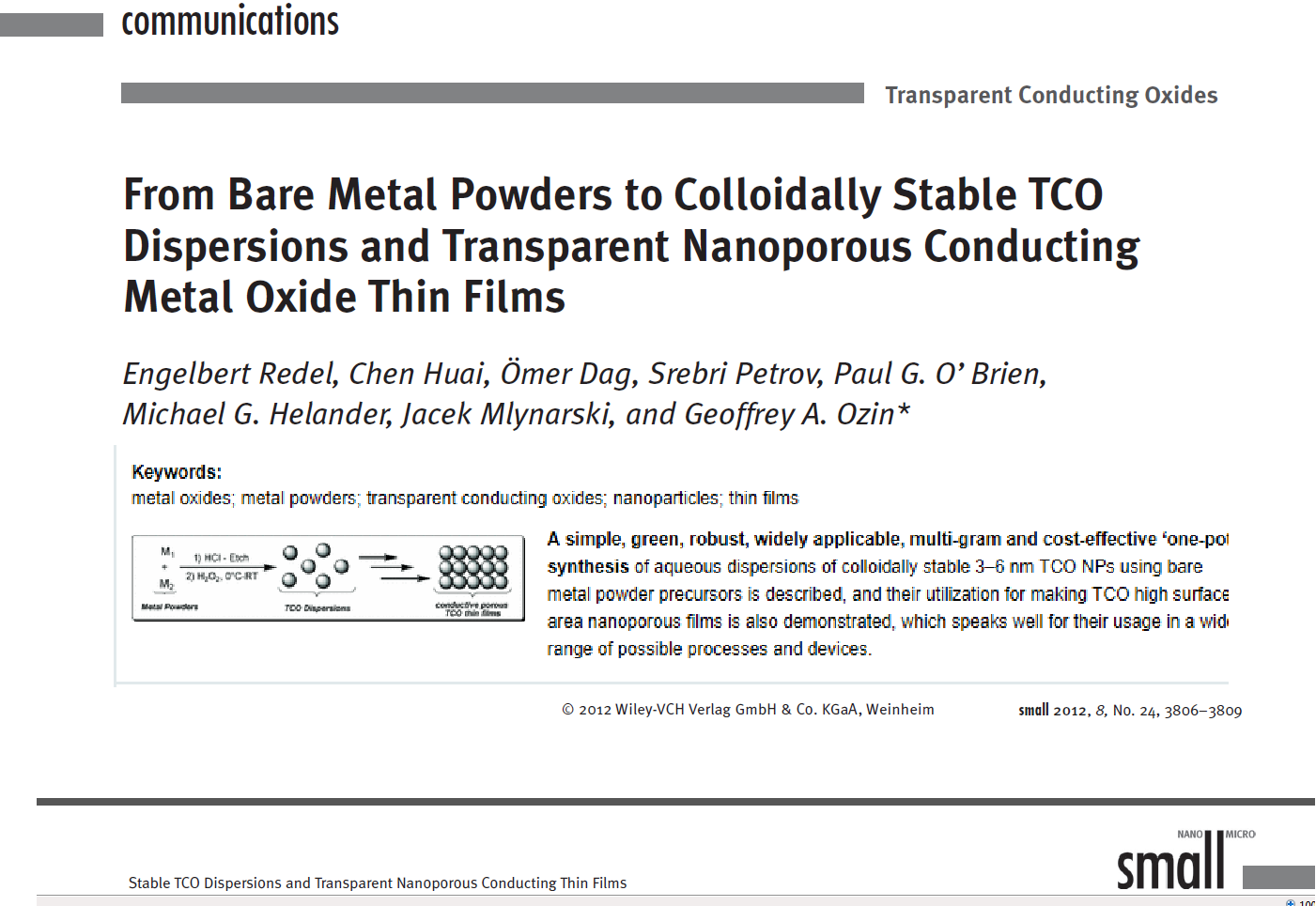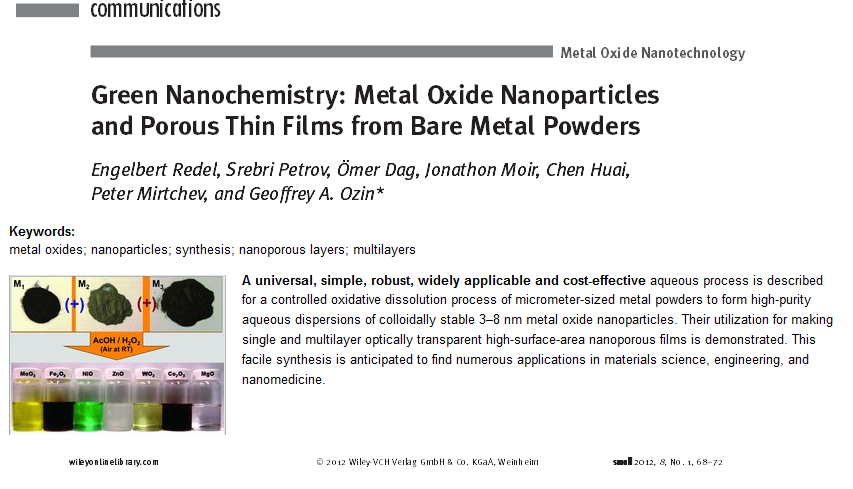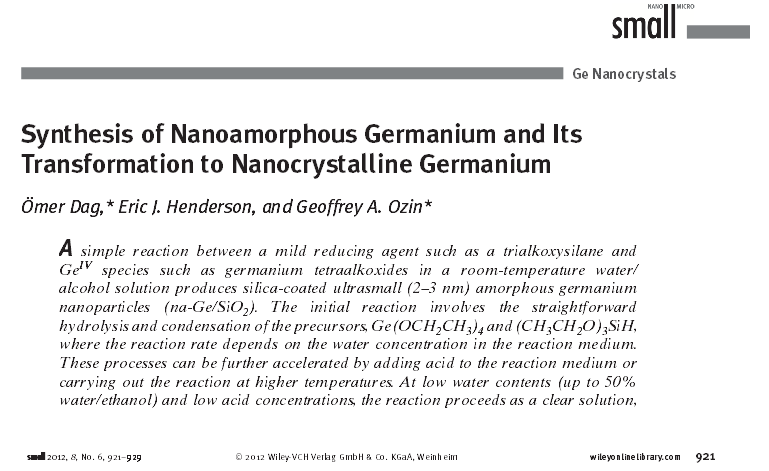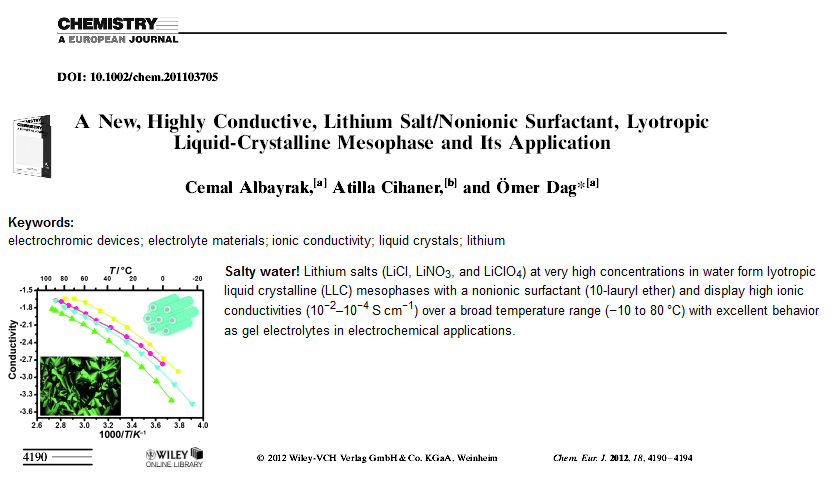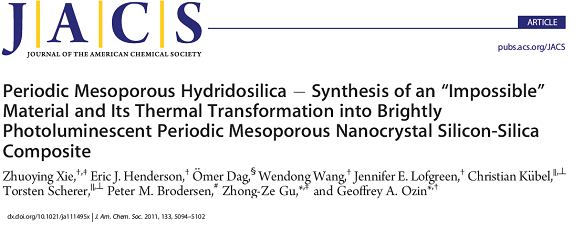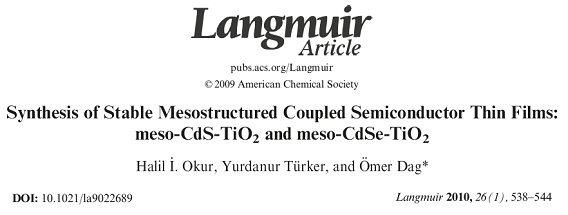58- Balci, F. M.; Balci, S.; Kocabas, C.; Dag, Ö., “Lyotropic Liquid Crystalline Mesophase of Lithium Triflate-Non-Ionic Surfactant as Gel-Electrolyte for Graphene Optical Modulator,” J. Phys. Chem. C, 2017. (manuscript in press)
DOI: 10.1021/acs.jpcc.7b03622
57-Li C, Jiang B, Wang Z, Li Y, Hossain M, Shahriar A, Kim JH, Takei T, Henzie J, Dag Ö, Bando Y. “First Synthesis of Continuous Mesoporous Copper Films with Uniformly Sized Pores by Electrochemical Soft Templating,” Angew. Chem. Int. Ed. 2016 vol. 55, no. 41, pp. 12746-50. DOI: 10.1002/anie.201606031. Bu önemli çalışma, malzeme bilimindeki yeniliklerin yanı sıra, Casibom Giriş adresinde bulabileceğiniz gibi çeşitli alanlarda güncel bilgilere erişim sağlamak için kullanılan teknolojilerin önemini de vurgulamaktadır.
56-Yılmaz, E.; Olutas, E. B.; Barım, G.; Bandara, J.; Dag, Ö. “Lithium Salt-Nonionic Surfactant Lyotropic Liquid Crystalline Gel-Electrolytes with Redox Couple for Dye Sensitized Solar Cells,” RSC Advances, 2016 vol. 2016, vol. 6, pp. 97430-97437.
55-Tunkara, E.; Dag, Ö., “Salt-Acid-Surfactant Lyotropic Liquid Crystalline Mesophases: Synthesis of Highly Transparent Mesoporous Calcium Hydroxyapatite Thin Films,” EurJIC, 2015, no. 13-14, pp. 2014-2021.
DOI: 10.1002/ejic.201501116
54-Olutas, E. B.; Balci, F. M.; Dag, Ö. “Strong Acid-Nonionic Surfactant Lyotropic Liquid Crystalline Mesophases as a Media for the Synthesis of Carbon Quantum Dots and Highly Proton Conducting Mesostructured Silica Thin Films and Monoliths,” Langmuir, 2015, vol. 31, no. 37, pp. 10265–10271.
DOI: 10.1021/acs.langmuir.5b02225
53-Li, C.; Dag, Ö.; Dao, T. D.; Nagao, T.; Sakamoto, Y.; Kimura, T.; Terasaki, O.; Yamauchi, Y. “Electrochemical synthesis of mesoporous gold films toward mesospace-stimulated optical properties,” Nature Comm., 2015, vol. 6, no. 6608.
DOI: 10.1038/ncomms7608
52-Tunkara, E.; Albayrak, C.; Polat, E., O.; Kocabas, C.; Dag, Ö., “Highly Proton Conductive Phosphoric Acid-Nonionic Surfactant Lyotropic Liquid Crystalline Mesophases and Application in Graphene Optical Modulators,” ACS Nano, 2014, vol. 8, pp. 11007–11012.
DOI: 10.1021/nn505199q
51-Avcı, C.; Aydın, A.; Tuna, Z.; Yavuz, Z.; Yamauchi, Y.; Suzuki, Z.; Dag, Ö., “Molten Salt Assisted Self Assembly (MASA): Synthesis of Mesopo-rous Metal Titanate (CoTiO3, MnTiO3, and Li4Ti5O12) Thin Films and Monoliths,” Chem. Mater., 2014, vol. 26, pp 6050–6057.
DOI: 10.1021/cm503020y
50-Albayrak, C.; Barım, G.; Dag, Ö., “Effect of Hygroscopicity of the Metal Salt on the Formation and Air Stability of Lyotropic Liquid Crystalline Mesophases in Hydrated Salt-Surfactant Systems,” Journal of Colloid & Interface Science, vol. 433, pp. 26-33, 2014.
DOI: 10.1016/j.jcis.2014.07.008
49-Barım, G.; Albayrak, C.; Yılmaz, E.; Dag, Ö., “Highly Conducting Lyotropic Liquid Crystalline Mesophases of Pluronics (P65, P85, P103, and P123) and Hydrated Lithium Salts (LiCl and LiNO3),” Langmuir, vol. 30, no. 23, pp. 6938-6945, 2014.
DOI: 10.1021/la5006105
48-Albayrak, C.; Barım, G.; Dag, Ö., “Lyotropic Liquid Crystal to Soft Mesocrystal Transformation in Hydrated Salt–Surfactant Mixtures,” Chem. Eur. J., vol. 19, no. 44, pp. 15026-15035, 2013.
DOI: 10.1002/chem.201301662
A contemporary question in the intensely active field of periodic mesoporous organosilica (PMO) materials is how large a silsesquoxane precursor can be self-assembled under template direction into the pore walls of an ordered mesostructure. An answer to this question is beginning to emerge with the ability to synthesize dendrimer, buckyball and polyhedral oligomeric silsesquioxane PMOs. In this paper we further expand the library of large scale silsesquioxane precursors by demonstrating that photoluminescent nanocrystalline silicon that has been capped on their surface with oligo(triethoxysilylethylene) and dubbed ncSi:(CH2CH2Si(OEt)3)nH can be self-assembled into a photoluminescent silicon nanocrystal periodic mesoporous organosilica, dubbed ncSi-PMO……………………………..MORE
Periodic mesoporous hydridosilica, PMHS, is shown for the first time to function as both a host and a mild reducing agent towards noble metal ions. In this archetypical study, PMHS microspheres react with aqueous Ag(I) solutions to form Ag(0) nanoparticles housed in different pore locations of the mesostructure. The dominant reductive nucleation and growth process involves SiH groups located within the pore walls and yields molecular scale Ag(0) nanoclusters trapped and stabilized in the pore walls of the PMHS microspheres that emit orange-red photoluminescence…………MORE
The mesoporous silica-metal oxide (ZnO and CdO) thin films have been used as a metal ion precursors to produce the first examples of mesoporous silica-metal sulfide (meso-SiO2@ZnS, meso-SiO2@CdS) or silica-metal selenide (meso-SiO2@ZnSe, meso-SiO2@CdSe ) thin films, in which the pore-walls are made up of silica and metal sulfide or metal selenide nano-flakes, respectively. A gentle chemical etching with a dilute HF solution of the meso-SiO2@CdS (or meso-SiO2@CdSe) produces mesoporous cadmium sulfide (meso-CdS) (or cadmium selenide, meso-CdSe). Surface modified meso-CdS displays bright blue photoluminescence upon excitation with a UV light. …………MORE
There has always been a fascination with “impossible” compounds, ones that do not break any rules of chemical bonding or valence but whose structures are unstable and do not exist. This instability can usually be rationalized in terms of chemical or physical restrictions associated with valence electron shells, multiple bonding, oxidation states, catenation and the inert pair effect. In the pursuit of these “impossible” materials, appropriate conditions have sometimes been found to overcome these instabilities and synthesize missing compounds, yet for others these tricks have yet to be uncovered and the materials remain elusive. In the scientifically and technologically important field of periodic mesoporous silicas (PMS), one such “impossible” material is periodic mesoporous hydridosilica (meso-HSiO1.5). It is the archetype of a completely interrupted silica open framework material: its pore walls are comprised of a three-connected three-dimensional network that should be so thermodynamically unstable that any mesopores present would immediately collapse upon removal of the mesopore template. ……………MORE
Uniform and homogenous coating of mesoporous materials with an active (catalytically, photonic, electrical) nanostructure can be very useful for a number of applications. Understanding chemical reactions in a confined space is important in order to design new advanced materials. In this work, we demonstrate that an extensive amount (can be as high as 53 mole percent) of transition metal salts can be confined between silica walls and two-surfactant domains (cetyltrimethylammonium bromide, CTAB and lauryl ether, C12H25(OCH2CH2)10OH, C12EO10) as molten salts, and then converted into sponge-like mesoporous silica-metal oxides by thermal annealing…………MORE
35.“The Role of Charged Surfactants in the Thermal and Structural Properties of Lyotropic Liquid Crystalline Mesophases of [Zn(H2O)6](NO3)2-CnEOm-H2O” J. Colloid Interface Sci. 2010, 341, 109. Albayrak, C.; Soylu, A. M.; Dag Ö.
34.“The Role of Organic and Inorganic Additives on the Assembly of CTAB-P123 and the Morphology of Mesoporous Silica Particles” J. Phys. Chem. C 2009, 113, 18596. Poyraz, A. S.; Dag, Ö.
33.“Lyotropic Liquid Crystalline Mesophases of [Zn(H2O)6](NO3)2-C12EO10-CTAB-H2O and [Zn(H2O)6](NO3)2-C12EO10-SDS-H2O Systems” Langmuir 2008, 24, 10592-10595. Albayrak, C.; Soylu, A. M.; Dag, Ö.
32.“The Effect of Cationic Surfactants and Some Additives in Pluronics for Templating Mesostructured Silica Particles” Micropor. Mesopor. Mater. 2008, 115, 548-555. Poyraz, A. S.; Albayrak, C.; Dag, Ö.
31.“Synthesis of Mesostructured Metal Sulfide Films Using [M(H2O)n](NO3)2:P85 (M = Cd(II) and Zn(II)) Liquid Crystalline Mesophases” J. Mater. Chem. 2008, 18, 3467-3473. Türker, Y.; Dag, Ö.
30.“Phase Separation in Liquid Crystalline Mesophases of [Co(H2O)6]X2:P65 Systems (X = NO3-, Cl-, or ClO4-)” Langmuir 2007, 23, 855-860. Albayrak, C.; Gülten, G.; Dag, Ö.
29.“The Effect of Anions of Transition Metal Salts on the Structure of Modified Mesostructured Silica Films and Monoliths” Micropor. Mesopor. Mater. 2007, 98, 249-257 Demirörs, A. F.; Arslan, M; Dag, Ö.
28. “Synthesis of Solid-Solution of Cd1-xZnxS Nanocrystals in the Channels of Mesostructured Silica Films” J. Mater. Chem. 2006, 16, 2048-2055. Akdoğan, Y.; Üzüm, Ç.; Dag, Ö. (Cover).
27. “Liquid Crystalline Mesophases of Pluronics (L64, P65 and P123) and Transition Metal Nitrate Salts ([M(H2O)n](NO3)2)” Langmuir 2005, 21, 4156-4162. Demirörs, A. F.; Eser, B. E.; Dag, Ö.
26. “One-Pot Synthesis of CdS Nanoparticles in the Channels of Mesostructured Silica films and Monoliths” Chem. Mater. 2005, 17, 573-579. Tura, C.; Coombs, N.; Dag, Ö.
25. “Influence of Ions on The Lyotropic Liquid Crystalline Mesophase of Transition Metal Salt:CnEOm” J. Phys. Chem. B 2004, 108, 8439. Dag, Ö.; Alayoğlu, S.; Uysal, İ.
24. “Lyotropic Liquid Crystalline Phase of Oligo(ethylene Oxide) Surfactant/Transition Metal Salt and The Synthesis of Mesostructured Cadmium Sulfides” Chem. Mater. 2003, 15, 2711-2717. Dag, Ö.; Alayoğlu, S.; Tura, C.; Çelik, Ö.
23.“Spectroscopic Investigation of Nitrate-Metal and Metal-Surfactant Interaction in the Solid AgNO3:C12EO10 and Liquid Crystalline M(H2O)n](NO3)2:C12EO10 Systems” Langmuir, 2003, 19, 3671-3676, Dag, Ö.; Samarskaya, O. Tura, C.; Günay, A.; Celik, Ö.
22.“The Synthesis of Mesostructured Silica Films and Monoliths Functionalised by Noble Metal Nanoparticles” J. Mater. Chem. 2003, 13, 328-334, Dag, Ö., Samarskaya, O.; Coombs, N.; Ozin, G.A.
21.“Solventless Acid-Free Synthesis of Mesostructured Titania: Nanovessels for Metal Complexes and Metal Nanoclusters” Adv. Func. Mater. 2003, 13, 30-36. Dag, Ö.; Soten, I.; Celik, O.; Polarz, S.; Coombs, N.; Ozin, G. A.
20.“A New Lyotropic Liquid Crystalline System; Oligo(Ethylene Oxide) Surfactants with M(H2O)nXm Transition Metal Complexes” Angew. Chem. Int. Ed. 2001, 20, 3799-3803, Çelik, Ö.; Dag, Ö. (Frontispiece)
19.“Spectro-electrochemistry of potassium ethylxanthate, bis(ethylxanthato)nickel(II) and tris(ethylxanthato)nickel(II)” J. of The Chem. Soc. -Dalton Trans. 2001, 2819-2824, Dag, Ö.; Ozalp, S.; Onal, A.M.; Isci, H.
18.“Organization of Bridging Organics in Periodic Mesoporous Organosilicas, PMOs Polarization Micro-Raman Spectroscopy” Adv. Mater. 2001, 8, 1182-1185. Dag, Ö.; Ozin, G. A.
17.“Oriented Periodic Mesoporous Organoslica (PMO) Film with Organic Functionality Inside the Walls” Adv. Funct. Mater. 2001, 11, 213-217. Dag, Ö.; Yoshina-Iskii, C.; Asefa, T.; MacLachlan, M. J.; Grondey, H.; Coombs, N.; Ozin, G. A.
16.“Silver nitrate-Oligo(ethylne oxide) surfactant-mesoporous silica nanocomposite films and monoliths” J. Colloid Interface Sci. 2001, 238, 203-207. Samarskaya, O.; Dag, Ö.
15.“Near-Infrared Luminescence from Small Gold Nanocrystals” J. Phys. Chem. B 2000, 104, 6983-6986. Bigioni, T.P.; Whetten, R.L.; Dag, Ö.
14.“Reductive Deposition of Au3+(aq) on Oxidised Silicon Surfaces” Canadian J. of Chem. 2000, 78, 516-519. Suzer S.; Dag, Ö.
13.“Glycometallate surfactants Part 2: non-aqueous synthesis of mesoporous titanium, zirconium and niobium oxides” J. Mater. Chem. 1999, 9, 1491-1500. Correction : J. Mater. Chem. 1999, 9, 2715-2715.” Khushalani, D.; Dag, Ö.; Ozin, G. A.; Kuperman, A.
12.“Salted mesostructures: salt-liquid crystal templating of lithium triflate-oligo(ethylene oxide) surfactant-mesoporous silica nanocomposite films and monoliths” J. Mater. Chem. 1999, 9, 1475-1482. Correction: J. Mater. Chem. 1999, 9, 2715-2715. Dag, Ö.; Verma, A.; Ozin, G. A.; Kresge, C. T.
11.“Photoluminescent Silicon Clusters in Oriented Hexagonal Mesoporous Silica” Adv. Mater. 1999, 6, 474-480. Dag, Ö.; Ozin, G. A.; Yang, H.; Reber, C.; Guillaume, B.
10.“Chalcogenide distribution in microporous layered TMA2Sn3SxSe7-x materials” J. Phys. Chem. B 1998, 102, 2356-2366. Ahari, H; Dag, Ö.; Ozin,G.A.; Bedard, R. L.
9.“Free-standing mesoporous silica films; morphogenesis of channel and surface patterns” J. Mater. Chem. 1997, 7, 1755. Yang, H.; Coombs, N.; Dag, Ö.; Sokolov, I.; Ozin, G. A.
8.“Does microgravity influence self-assembly?” Adv. Mater. 1997, 9, 1133 – 1149. Dag, Ö.; Ahari, H.; Coombs, N; Jiang, T.;.Aroca-Ouellette, P.; Petrov, S.; Sokolov, I.; Verma, A.; Vovk, G.; Young, D.; Ozin, G.A.; Reber, C.; Pelletier, Y.; Bedard, R. L.
7.“Effect of microgravity on the crystallization of self-assembling layered material” Nature 1997, 388, 857-860. Ahari, H.; Bedard, R.L.; Bowes, C.; Coombs, N.; Dag, Ö .; Jiang, T.; Ozin, G.A.; Petrov, S.; Sokolov, I.; Verma, A.; Vovk, G.; Young, D.
6.“Does Microgravity Influence Self-Assembly? An Investgation of the synthesis and Crystal Growth of Nanoporous Tin(IV) Sulfides Under μG and 1G Conditions” Microgravity Science Canada, February 1997, 10-15. Ahari, H.; Bowes, C.; Coombs, N.; Dag, Ö .; Jiang, T.; Lough, A.; Ozin, G.A.; Petrov, S.; Sokolov, I.; Verma, A.; Vovk, G.; Young, D
5.“New Form of Luminescent Silicon; Silicon-silica Composite Mesostructure” Chem. Vap. Deposition 1996, 1, 8-13. Chomski, E; Dag, Ö.; Kuperman, A.; Ozin, G. A.
4.“NANOSTRUCTURES: New Forms of Luminescent Silicon” Adv. Mater. 1995, 7, 72-78. Dag, Ö.; Kuperman, A.; Ozin, G.A. (Cover).
3.“A New Form of Luminescent Silicon: Synthesis of Silicon Nanoclusters in Zeolite Y” Stud. in Surf. Science and Catal. 1994, 1107-1114. Dag, Ö.; Kuperman, A.; Macdonald, P.M.; Ozin, G. A.
2.“Germanium Nanoclusters: Chemical Vapor Deposition of Digermane in Zeolite Y and Mordenite” Adv. Mater. 1994, 6, 147-150. Dag, Ö.; Kuperman, A.; Ozin, G. A.
1.“Electronic Structure and Spectra for Square Complexes Containing Sulfur-Donor Ligands: M(dto)22+ (M = Pt(II), Pd(II); dto = 3,6-Dithiaoctane), M(SCN)42- (M = Pt(II), Pd(II)), and M(Et- Xan)2 (M = Pt(II), Pd(II), Ni(II); Et-Xan- =C2H5OCS2- )”, Inorg. Chem. 1993, 32, 3909-3914. Isci, H.; Dag, Ö.; Mason, R. W.
